Hair transplantation is a surgical technique that moves individual hair follicles from a part of the body called the 'donor site' to bald or balding part of the body known as the 'recipient site'.
In this minimally invasive procedure, grafts containing hair follicles that are genetically resistant to balding, like the back of the head, are transplanted to the bald scalp.
Hair Transplantation can also be used to restore eyelashes, eyebrows, beard hair, chest hair, pubic hair and to fill in scars caused by accidents or surgery such as face-lifts and previous hair transplants.
Hair transplantation differs from skin grafting in that grafts contain almost all of the epidermis and dermis surrounding the hair follicle, and many tiny grafts are transplanted rather than a single strip of skin.
Since hair naturally grows in groupings of 1 to 4 hairs, today’s most advanced techniques harvest and transplant these naturally occurring 1–4 hair "follicular units" in their natural groupings. Thus modern hair transplantation can achieve a natural appearance by mimicking nature hair for hair. This hair transplant procedure is called Follicular unit transplantation (FUT). Donor hair can be harvested two different ways: strip harvesting, and follicular unit extraction (FUE).
At an initial consultation, the surgeon analyzes the patient's scalp, discusses their preferences and expectations, and advises them on the best approach (e.g. single vs. multiple sessions) and what results might reasonably be expected. Some patients may benefit with preoperative topical minoxidil application and vitamins.
For several days prior to surgery the patient refrains from using any medicines which might result in intraoperative bleeding and resultant poor "take" of the grafts. Alcohol and smoking can contribute to poor graft survival. Post operative antibiotics are commonly prescribed to prevent wound or graft infections.
Transplant operations are performed on an outpatient basis, under local anesthesia, which typically last about six hours. The scalp is shampooed and then treated with an antibacterial agent prior to the donor scalp being harvested.
There are several different techniques available for the harvesting of hair follicles, each with their own advantages and disadvantages. The choice of technique depends upon surgeons preference and his/her decision for individual case.
There are two main ways in which donor grafts are extracted today: strip excision harvesting, and follicular unit extraction.
Strip harvesting is the most common technique for removing hair and follicles from a donor site. The surgeon harvests a strip of skin from the posterior scalp (back portion of the head), in an area of good hair growth. Each incision is planned so that intact hair follicles are removed. The excised strip is about 1–1.5 x 15–30 cm in size.
After harvesting the strip the surgeon will close the resulting wound with suture, and in the same time the team of technician begin to dissect individual follicular unit grafts, which are small, naturally formed groupings of hair follicles, from the strip. Working under magnification, they carefully remove excess fibrous and fatty tissue while trying to avoid damage to the follicular cells that will be used for grafting.
The latest method of closure is called 'Trichophytic closure' which results in much finer scars at the donor area.
These embedded hair roots will give rise to new hair from this scarline giving scar less appearance to strip method.

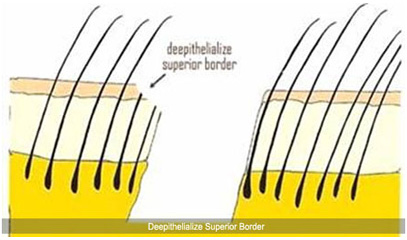
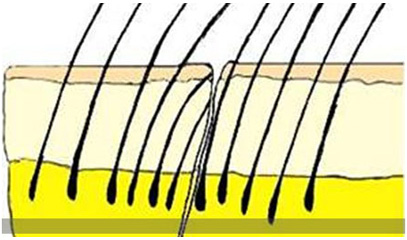
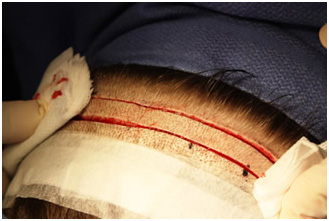
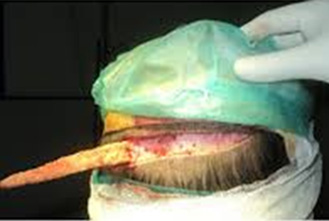
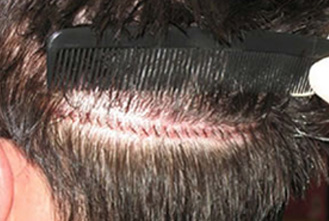
With Follicular Unit Extraction or FUE harvesting, individual follicular units containing 1 to 4 hairs are removed under local anesthesia; this micro removal typically uses tiny punches of between 0.6mm and 1.0mm in diameter.
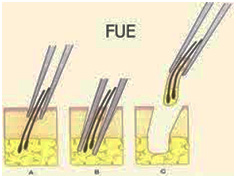
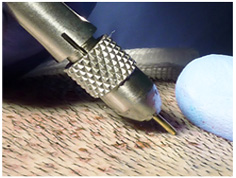
FUE takes place in a single long session or multiple small sessions. The FUE procedure is more time consuming than strip surgery. An FUE surgery time varies according to the surgeons experience, speed in harvesting and patient characteristics. The procedue can take anywhere from a couple hours to extract 200 grafts for a scar correction to a surgery over two consecutive days for a megasession of 2,500 to 3,000 grafts. With the FUE Hair Transplant procedure there are restrictions on patient candidacy.
FUE can give very natural results. The advantage over strip harvesting is that FUE harvesting negates the need for large areas of scalp tissue to be harvested, so there is no linear incision on the back of the head and it doesn't leave a linear scar. Because individual follicles are removed, only small, punctate scars remain which are virtually not visible and any post-surgical pain and discomfort is minimized. As no suture removal is required, recovery from Micro Grafting FUE is less than 7 days.
Disadvantages include increased surgical times and higher cost to the patient. Some surgeons note that FUE can lead to a lower ratio of successfully transplanted follicles as compared to strip harvesting. Others also suggest that in case a patient would need more than one transplant, it would be difficult to find a good strip after an FUE.
FUE doesn’t close the wounds, this means that the donor scars will not be reduced. For FUT, when 30 cm of donor is extracted, the closure of the scar will be reduced to one tenth of its original size. Depending on the surgeon’s skill, the results could be even better. In contrast, the FUE procedure will leave 30 cm square of scars widespread and much larger depending on the tension of scalp. This will cause the scars to stretch further. There will be 3000 round punch hole scars distributed all over the donor site for the remainder of your life. It will be permanent and not disappear over time. When your hair begins to thin, the scars over the safe zone and the thousands of scars will start to become even more noticeable.
The surgeon then uses very small micro blades or fine needles to puncture the sites for receiving the grafts, placing them in a predetermined density and pattern, and angling the wounds in a consistent fashion to promote a realistic hair pattern. The technicians generally do the final part of the procedure, inserting the individual grafts in place.
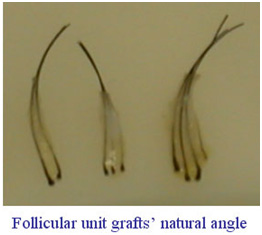
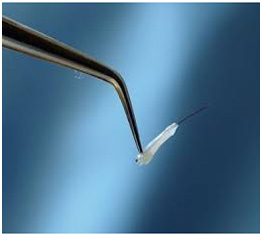
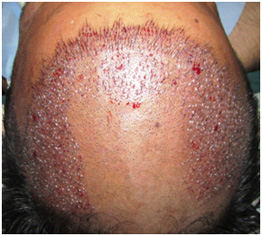
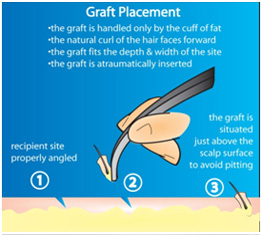
Advances in wound care allow for semi-permeable dressing, which allow seepage of blood and tissue fluid, to be applied and changed at least daily. The vulnerable recipient area must be shielded from the sun, and shampooing is started two days after the surgery. Some surgeons will have the patient shampoo the day after surgery. Shampooing is important to prevent scabs from forming around the hair shaft. Scabs adhere to the hair shaft and increase the risk of losing newly transplanted hair follicles during the first 7 to 10 days post-op.
During the first ten days, virtually all of the transplanted hairs, inevitably traumatized by their relocation, will fall out. This is referred to as "shock loss". After two to three months new hair will begin to grow from the moved follicles. The patient's hair will grow normally, and continue to thicken through the next six to nine months. Any subsequent hair loss is likely to be only from untreated areas. Some patients elect to use medications to retard such loss, while others plan a subsequent transplant procedure to deal with this eventuality.
Hair thinning, known as "shock loss", is a common side effect that is usually temporary. Bald patches are also common, as fifty to a hundred hairs can be lost each day.
Other side effects include swelling of areas such as the scalp and forehead. If this becomes uncomfortable, medication may ease the swelling. Additionally, the patient must be careful if their scalp starts itching, as scratching will make it worse and cause scabs to form. A moisturizer or massage shampoo may be used in order to relieve the itching.